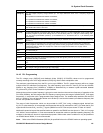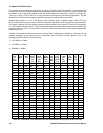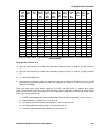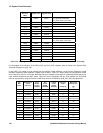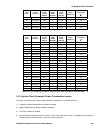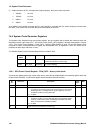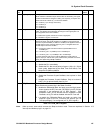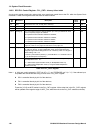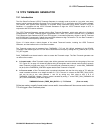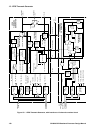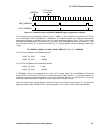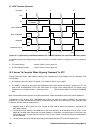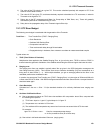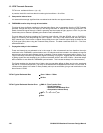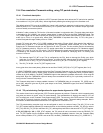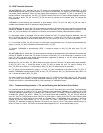15: 1PPS Timemark Generator
GP4020 GPS Baseband Processor Design Manual 149
15 1PPS TIMEMARK GENERATOR
15.1 Introduction
The One Pulse Per Second (1PPS) Timemark Generator is nominally used to provide a 1 ms pulse, once every
second, which is phase-aligned to Universal Time Co-ordinated (UTC), in conjunction with GPS system software.
The Navstar GPS system relies absolutely on accurate timing information using Atomic clocks in the GPS
Satellites. It is possible with the 1PPS Timemark Generator to align the 1PPS Timemark output to UTC, in
conjunction with GPS receiver software.
The 1PPS Timemark Generator operates with the Raw Timemark Generator, which exists within the 12-channel
correlator block. The Raw Timemark signal is generated from a clock (TIC) which is derived from a 10.000MHz
TCXO Receiver Clock Reference (RCR) on a GPS receiver, via numerous frequency dividers in the RF Front-end
and GP4020 itself. Consequently, without the use of GPS software to align Timemark to TIC, the Raw Timemark is
only as accurate as the frequency stability of the TCXO.
Figure 15.1 below shows a block diagram of the whole Timemark function, including the 1PPS Timemark
Generator, and the interface to the 12-channel correlator.
The Timemark output can be accessed from TIMEMARK / TIC (pin 69 (100-pin package)) of the GP4020.
Timemark is the default signal, but TIC can also be accessed from this pin by setting the TIC_TIME bit (bit 7) in the
TIC_RET register.
RAW_TIMEMARK must be activated in order to access the Timemark output. The Raw Timemark generator can
run either of two modes:
• In Armed mode, a Raw Timemark output pulse will be generated coincident with the rising edge of the next
TIC. Figure 15.2 on page 151 shows the relative timing of the signals used in Armed mode, across 2 seconds,
when Timemark is trigger once every 10 TICs. Armed-mode is enabled by writing '1' to the ARM_TIMEMARK
bit (bit 0) of the TIMEMARK_CONTROL register before Each Timemark is required.
• In Free-run mode, a Raw Timemark pulse is produced coincident with the first rising edge of TIC after the
mode is enabled, and then on an integer number of 'n' TICs. The ratio 'n' is known as the FREE_RUN_RATIO,
and can be set to any value between 1 and 32 by writing any 5-bit value to bits 2 to 6 of
TIMEMARK_CONTROL register. Free-run mode is enabled by writing '1' to the FREE_RUN_TIMEMARK bit
(bit 1) of the TIMEMARK_CONTROL register.
TIMEMARK Period = (FREE_RUN_RATIO + 1) * TIC Period (Free run mode)
Of the two modes, normally Armed mode is more useful, since software will have more control on which
TIC will trigger a Raw Timemark pulse.



